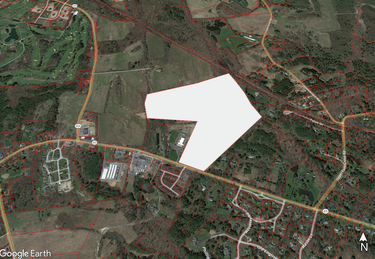Zoning board raises concerns about large solar facility for New Scotland Hamlet
NEW SCOTLAND — A large-scale solar proposal is facing skepticism from the New Scotland Zoning Board of Appeals over its location as well as the variance requests the project is seeking.
New Scotland PV, LLC is seeking a use variance and two area variances for the installation of a 5 megawatt ground-mounted solar photovoltaic farm at what is being called Zero New Scotland Road, a nearly 75-acre parcel of land located between 1857 and 1891 New Scotland Road that shares a half-mile of property line with the 176-acre Mohawk Hudson Land Conservancy Bender Melon Farm Preserve.
The property is owned by Peter Baltis.
New Scotland PV is an LLC set up by RIC Energy out of Manhattan, which is overseeing the proposal.
The use variance New Scotland PV is seeking is to be able to site a solar facility outside a permitted zoning district while the area variances are for siting a solar facility on land with more than an acre of mature forests and for siting a solar facility on a parcel with prime farmlands.
Proposed solar projects in New Scotland are highly scrutinized, in part because of the way the town’s 2017 solar law was written.
The law says that no large-scale projects are permitted on:
— Land that has prime soils, defined as “land that has the best combination of physical and chemical characteristics for producing food, feed, forage, fiber, and oilseed crops and that is available for these uses”
— Land that has soils of statewide importance, “where less than 50 percent of the components in the [area] are prime but a combination of lands of prime or statewide importance is 50 percent or more of the [area] composition”; or
— Land that has more than an acre of mature forest, which contains trees that are predominantly six inches in diameter or more.
The project parcel, according to the applicant, contains approximately 26 acres of either prime farmland or soils of statewide importance; the solar facility would sit on about 9.4 acres of these soils. About 29 of the property’s 75 acres are covered by mature forest, of which RIC is proposing to clear-cut 5.7 acres.
New zoning board Chairwoman Erin Casey asked what hardship would actually be suffered by the applicant given RIC doesn’t own the land, because “it’s really about the owner of the property … if this were not approved … You don’t have the hardship of owning this property and not being able to put a solar array on it.”
Camille Warner, a project manager with RIC Energy, said Baltis wasn’t interested in farming the land, which has significant wetlands, which is why he doesn’t want to put housing on the property: “Residential is not allowed in wetlands,” Warner said.
The site is approximately 20 percent wetlands, the board was told.
Criteria
Warner used the rest of her time during the Sept. 27 meeting to walk the board through the checklist it uses when determining whether or not to grant a variance to make the case on why the project deserves the requested variances.
Each area variance request, to be granted, had to pass five criteria used by the zoning board:
— Whether the variance request would create an undesirable change in neighborhood character or cause detriment to nearby properties.
Warner said the proposed facility wouldn’t “generate pollution, waste, noise, odor, traffic, or anything that will negatively impact” the surrounding area.
She also said the project’s proposed setbacks coupled with its existing and proposed landscaping would “really visually screen this property from” neighbors and passers-by.
Warner was told the screening plan for the project was “a little bit of a pipe dream,” because the facility would “be seen from multiple locations,” including routes 85 and 85A and the homes located behind the facility, in the Font Grove neighborhood.
“It’s going to have a visual impact,” she was told.
Warner said RIC had yet to conduct a visual impact analysis, so she can’t “officially say [whether] the viewpoints will be seen or not seen ….”;
— Whether there are other ways for an applicant to achieve the same level of benefit without having to seek an area variance.
Warner said RIC looked but couldn’t find another willing landowner and parcel in New Scotland suitable for a solar facility;
— Whether the requested variance is substantial.
Warner said the project “will not remove land from active ag; it’s not currently an active ag [land use]. Farming can be a viable option in the future, if the landowner wants it to be. The clearing will not substantially reduce the existing forest interior, or cause disruption to wildlife habitats or wildlife corridors.”
It was noted by planning board members who drive by the parcel on their way to and from work that there are deer and turkey on the property at all hours of the day and night;
— Whether the proposed variance would adversely affect a neighborhood or district’s physical or environmental conditions.
Warner said, “One of the benefits of solar is that it allows the soil to remain fallow … Basically, in this time, where the soil is not being used for anything, nutrients are replenished, [and] beneficial microbes are allowed to increase along with levels of organic matter in the soil; and
— Whether “the alleged difficulty was self-created, which consideration shall be relevant to the decision of the ZBA, but shall not necessarily preclude the granting of the area variance.”
Warner said the project was designed to meet the state’s energy goals.
She then reiterated, “we did look for alternatives to site the project but we are limited by landowners, capacity, et cetera.” She added that the proposal “will not affect the town’s goal of retaining agricultural production.”
For a use variance to be granted, it has to pass four zoning board criteria:
— The applicant can’t “realize a reasonable return” under current zoning.
RIC, according to its application, “is a renewable energy company incapable of developing residential or mixed-use developments. Siting the solar facility elsewhere in the Town was investigated and deemed economically unfeasible due to environmental and engineering cost constraints”;
— The alleged hardship is unique to the property.
Warner said the hardship for the Baltis property is the amount of wetlands on site, “most of the parcels in the Hamlet District don’t have as much”;
— If granted, the use variance won’t alter neighborhood or district character.
Warner said the project would be situated next to a commercial facility and located on a road with other commercial facilities; and
— The alleged hardship wasn’t self-created.
“We are a solar company … so we are limited in our options to develop,” Warner told board members.
RIC attempted to site the facility on another parcel in a district that allowed large-scale solar, she said; the company did so by sending out a mass mailing looking for willing landowners.
When asked the number of responses to the mailing, another RIC representative told the board Baltis was the only serious response the company had received.
Casey responds
After Warner had finished her presentation, Chairwoman Casey said, “In my mind, this is a significant number and variety of variances that this project is seeking to obtain.” Both the use and area variance requests “present a challenge,” she said.
Casey said the board had to be very careful about “the precedents that we create,” especially in an area of town with such a “well-documented” and “well-thought out” development plan.
The Baltis property is located in the New Scotland Hamlet District, which is about to receive an update to its zoning, its second in four years; the parcel is situated in both the expansion and development areas of the hamlet — neither of which allow solar facilities.
Casey said more effort was needed on the part of the applicant to back-up statements “about there not being other suitable sites,” adding the board needed “more documentation of the efforts that have been made, the analysis that has been done, [and] why this is necessary.”
She also said, given solar facilities haven’t been allowed in the zoning district for some time, RIC had a self-created hardship on its hands. “You are attempting to put a solar site where one is not permitted, and you want to cut down mature forest, and it was an area with prime soils,” Casey said. “So, you know, none of this is new.”
Referring to RIC’s request to clear-cut 5.7 acres of mature forest, when New Scotland’s code allows for only one acre to be taken down for a solar facility, Casey said, “Whether a variance is substantial is not really a subjective criteria from, from our perspective … So in my mind, that is a substantial variance. And I think legal precedent probably backs me up on that.”
Zoning Board attorney Crystal Peck sought to raise two issues with the board.
When looking at a request for a use variance, one question that should be explored, Peck said, is the “viability of solar in other locations of the town — perhaps, locations in which it is permitted — because that is relevant to this analysis.”
The other issue Peck brought to the board’s attention was the town board, as part of its update to the town’s zoning code, specifically as it relates to the New Scotland Hamlet District, conducted a build-out analysis of all of the lots in the zoning district.
“It’s something that you should probably take a look at because it did analyze residential build-out on this specific lot. And it is something that the board should take into account when looking at the uses and the viability of those uses that are permitted for this lot,” Peck said.
The board ultimately decided to move forward with the proposal, setting up a $5,000 escrow account for planning and engineering services, and referring the project to the planning board.



